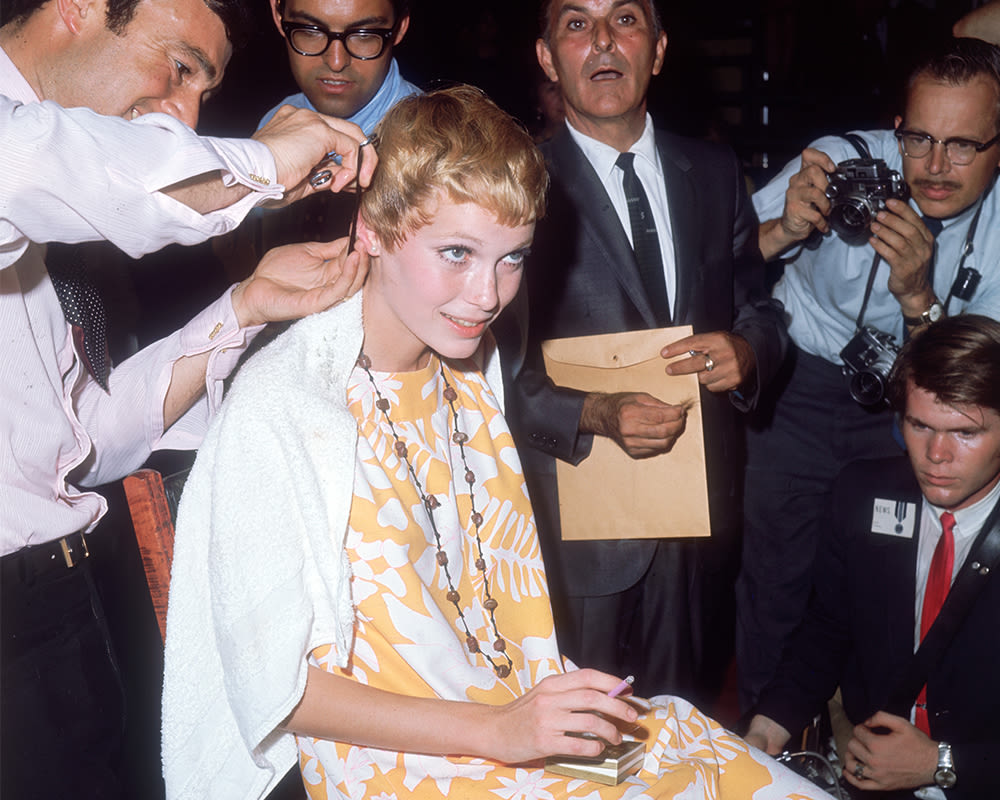There was probably a point in life when you, too, wanted “ The Rachel,” even if you didn’t know why. (No judgement.) Everyone had it—and it was really easy to ask for! You could feign hair knowledge simply by reading your weekly dose of People.
Of course, whether or not you ended up looking like Rachel is another story. Chances are you got some form of the lob—it just didn't have the ubiquitous name yet—that looked pretty good, just nothing like Jennifer Aniston. What she had, in more technical terms, was something akin to short layers at the crown of the head with a side-swept fringe, achieved with just a bit of disconnection. But People didn't say that. So unless you went to beauty school, how were you supposed to know?!
While a picture may be worth 1,000 words, being able to talk to your hairstylist in concrete terms is probably more useful. Communication is key, so we asked some of the industry’s top hairstylists for the must-know terms you should have in your vocabulary (or at least on your phone) next time you ask for a trim but really mean The Karlie.
Weight removal : “If you have thick, dense hair and desire something lighter, looser, and more flowing, then asking your stylist to take weight out of your hair is your best bet. This is done by using the scissors or a razor to carve out slivers of hair and lighten up the overall effect,” said Allen Thomas Wood, hairstylist at Bumble and bumble.
Undercut : Can be employed as a look or a means to an end. The latter technique lifts weight from your hair, the former can be anything from half a shaved head to a sliver of hair shaved underneath the top mantle of hair. Take it from celebrity hairstylist Jen Atkin, whose clients include Khloé Kardashian and Jennifer Lopez: “The undercut is one of the most popular hair techniques right now. It means to cut the hair underneath slightly shorter, while maintaining length on the top. Extreme versions of this are popular with super-short pixie cuts, but the same technique can be used in a much more subtle way to remove weight and bulk in a haircut while maintaining a longer, blunt finish.”
Razor : This is a hair-cutting tool used to remove volume from hair by collapsing the cut without adding layers, Edward Lampley, over at D+V, said. It can also be used to create texture, Jen added. “I love using it on fine hair types because it means I don't have to sacrifice the fullness of the hair. A razor works great to create movement on all hair types,” she said.
Understandably, a bad razor cut (often resulting in frayed ends) can train you to stay far away from them, but NY-based hairstylist at Little Axe Salon Rubi Jones wants you to know it takes a wise stylist to wield a razor. She says: “The razor should always be used very deliberately and should never damage your hair. Despite what people think, you can use a razor on straight hair, curly hair, super-curly hair, fine hair, medium hair, and especially on thick hair. The key to a good razor cut is a hairstylist’s training. Each part of that tiny—and sharp!—blade is meant to be used in a specific way. And when not used correctly, it can cause a bit of a disaster. Make sure to choose a stylist that's been well-trained before getting a razor cut.”
Blunt Cut : A haircut with no layers, cut straight-across where the weight falls on the bottom of the hair. Also known as a “solid” or “heavy” cut. “A stylist that uses scissors to create sharp, graphic lines will deliver this sort of cut,” Allen said. If your hair is thin, fine, or fragile, ask for this when you want a haircut that preserves the density and overall integrity of your hair, he added.
Point Cutting : Cutting hair with the scissors positioned vertically. “It’s one of my favorite techniques to add the lightest bit of texture to the hair ends. Very light point cuts create a softer edge,” Jen said.
Dusting : The term people who really mean “just a trim” need to know when they go into the salon. “It’s when you literally just cut the ends of the hairs that are split or broken,”—nothing else to it, Edward said.
Inch : “An inch is an inch,” Editorial Hairstylist James Pecis said. “Sometimes a few inches in the real world is a foot in the the client world. Refresh yourself with a ruler before you say 'a few inches.''
Layers : “Layers are separate from your overall hair length, they are shorter pieces of hair that are should seamlessly fall together and give your hair volume and dimension. They can be on the surface of your haircut or within it. You can't get one layer 'here and there' or 'just three layers,'' Rubi said. “Instead, you should use a reference spot for your shortest layer, and then all your layers will fall from there to where your overall hair length is,”
Short layers are used to create a choppy cut. Alternatively, Allen suggests the terms “flowing, blended, and seamless” for anyone with longer hair desiring the undone, effortless, beachy look. “By keeping the layers—both face-framing and throughout the back—long and seamless, this effect is achieved.”
Weight Line : The part of your hair cut that holds the most weight (think of it as the base).
Graduation : “The hair graduates from longer to short. This can relate to graduating the back of a bob or 'forward grad' refers to layering around the front of the hairstyle,” James said.
Bangs (aka Fringe) : Face-framing layer of hair cut over the eyes. Can be side-swept and blended into layers with the rest of your hair, blunt and heavy, cut straight-across, or light and wispy/choppy through point-cutting.
'Carve and Slice' : Individual curl-cutting technique where the hairstylist assesses each curl and carves out the haircut piece-by-piece rather than just taking length off from the bottom, which in turn could lead to a stacked pyramid effect.
Dry Cutting : Typically, this is a second-round of hair cutting done when hair is already styled and dry, but it can also be used as a primary cutting method that's great for attention to shape and detail. It also allows a hairstyle to be cut the way you prefer to wear your hair texture.
Bob : A haircut with the weight line at your chin/just below the ears. A lob is a slightly longer version of the bob, with the weight line grazing the collarbone.
Disconnection : Not connecting main sections of the hairstyle through seamless layers. When picked up, there will be a clear difference between the front and back of the hair or general sections.
Pixie : Short haircut close to the scalp. Not long enough to be considered a bob, even if you’re not looming on Mia Farrow territory.
Got any more? Add 'em to the list below.
Image via Getty. Get acquainted with the hair salon that's making LA cool again.

